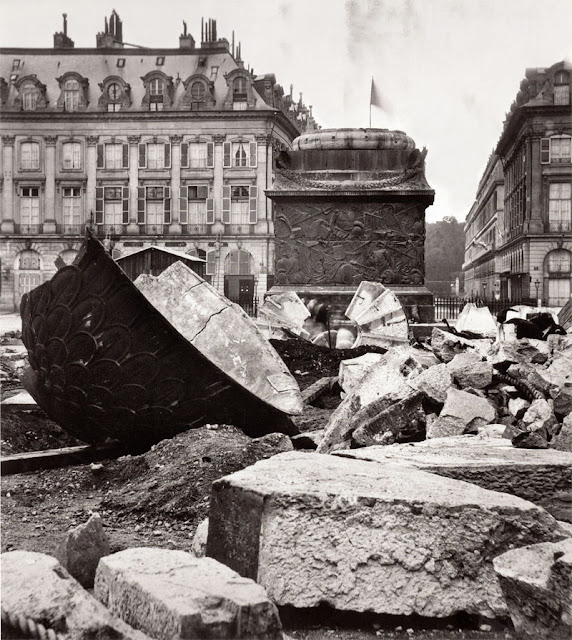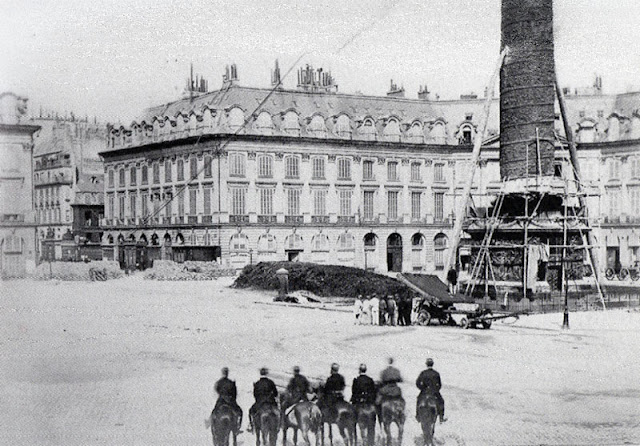.
La Colonne Vendôme au centre de la place du même nom, fut érigée en 1805 par Napoléon Ier en souvenir de la victoire d’Austerlitz.
Haute de 44,3 mètres, elle est composée de 76 anneaux de granite recouverts par 425 fines plaques de bronze. On raconte que celles ci sont issues de la fonte de 1200 canons pris aux armées russes et autrichiennes.
Le 12 avril 1871, durant la Commune de Paris, décision fut prise, sous l’instigation du peintre Courbet, de “déboulonner” la Colonne symbole du despotime des deux Empires.
L’opération fut prévue pour le 16 mai à 14h.
Le jour venu, la foule se presse sur la place ou des sièges ont été placés pour les dames. Les boutiques sont fermées et les vitres protégées. Les ouvriers mettent la dernière main à l’échafaudage. Une partie du monument est scié à un tiers, tandis qu’une profonde entaille de taille similaire est pratiquée de l’autre côté. Trois
cordages fixés en son sommet attendent d’être reliés au cabestan.
cordages fixés en son sommet attendent d’être reliés au cabestan.
La foule attend l’évènement avec fébrilité. Partout se propage la rumeur… Et si la colonne détruisait les fondations de l’Opéra ? Un lit de fumier et de sable placé au sol dans l’axe de la rue de la Paix doit amortir une chute dont on prétend qu’elle pourrait détruire les maisons de la place.
15h30: L’orchestre de la Garde Nationale entonne la Marseillaise à grand renfort de cuivre. Les ouvriers descendent de l’échafaudage. Les cordes se tendent. Le public retient son souffle. Au bout de quelques secondes, une poulie se brise, tuant un homme sur le coup. Ce contretemps imposera une légère réorganisation et un déblaiement additionnel de la place qui durera jusqu’à 17h15.
On tire à nouveau les cordages. Cette fois, la colonne vacille puis abandonne la lutte, se cassant en trois morceaux avant de toucher le sol.
Le nuage de fumée se dissipe. De la statue, il ne reste plus que le socle. Le corps de Napoléon qui ornait le sommet du monument, git décapité sur le dos. Un homme retrouvera la tête plus loin et d’un coup de pied la ramènera machinalement vers son propriétaire. Le métal sera récupéré pour être fondu à l’hotel de la Monnaie.
La Place Vendôme sera désormais baptisée “Place Internationale”.
La Place Vendôme sera désormais baptisée “Place Internationale”.
Après la chute de la Commune, Mac Mahon décidera de rebâtir la colonne au frais de Courbet. Le montant des travaux est fixé a 323.000 francs. Courbet sera condamné à verser 10000 francs par ans durant 33 ans. Il mourra en 1877 avant d’avoir pu honorer la première traite.
.
‘La Colonne Vendôme’, which stands at the centre of the Place de Vendôme, was erected in 1805 by Napoleon I, to commemorate his victory at Austerlitz. At a height of 44.3 metres, it comprises 76 blocks of granite, coated in 425 individual sheets of bronze. It is often said that this metal was extracted from the 1,200 cannons which were seized from the defeated Russian and Austrian armies.
On the 12th of April 1871, at the height of the Paris Commune, the artist Courbet commanded that the column be ‘ousted’, since it was seen as a symbol of the despotism of empire.
The operation was arranged for the 16th of May, at 2pm.
The operation was arranged for the 16th of May, at 2pm.
When the day came, crowds flooded into the square, where seats had been put out for the ladies. Shops and boutiques closed their doors and bolted down their windows. The Commune’s workmen completed their scaffold, and a deep fissure was hewn one third of the way up the monument; another was made on the opposite side.
And as three ropes were attached to the capstone, worried rumours began to spread through the pressing crowd: what if the fall of the column unsettled the foundations of the nearby opera house? For fear of the safety of nearby residences, a bed of manure and sand was placed at the the monument’s foot to soften its descent.
3pm: The brass band of the National Guard perform the Marseillaise. The workmen finally descend from the scaffolding. The cords are pulled. The crowds watch on hardly daring to breath. In the blink of an eye, all their fears are realised: one of the pulleys supporting the cords snaps in two, killing a man instantly – and causing such commotion that the event must be postponed for another two hours. At 5.15pm, the ropes are pulled again. This time, the enormous column totters terrifyingly for a moment, before it finally gives up the fight, crashing apart into three separate pieces before it even hits the ground.
Once the cloud of dust had dissapated, there was nothing left of this mighty statue but its plinth. The statue of Napoleon that had once graced its summit now lay decapitated on the cobblestones. The metal from his body would quickly be collected to melt at the nearby Mint, and the Place Vendôme was officially renamed the Place Internationale.
After the defeat of the Paris Commune, General MacMahon decided to rebuild the column, at the expense of the man who had ordered its destruction, Courbet – who would pay 10,000 francs a year, for the next 33 years, in order to meet the bill of 323,000f. He died in 1877, before having paid a single bill.
Once the cloud of dust had dissapated, there was nothing left of this mighty statue but its plinth. The statue of Napoleon that had once graced its summit now lay decapitated on the cobblestones. The metal from his body would quickly be collected to melt at the nearby Mint, and the Place Vendôme was officially renamed the Place Internationale.
After the defeat of the Paris Commune, General MacMahon decided to rebuild the column, at the expense of the man who had ordered its destruction, Courbet – who would pay 10,000 francs a year, for the next 33 years, in order to meet the bill of 323,000f. He died in 1877, before having paid a single bill.
(traduction: Tim Mc Inerney)
.








